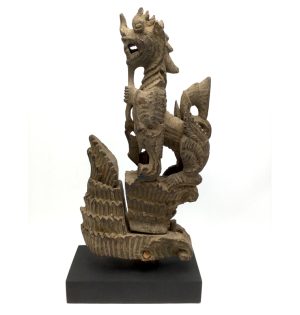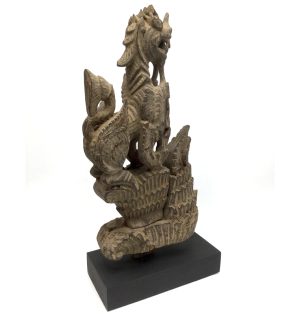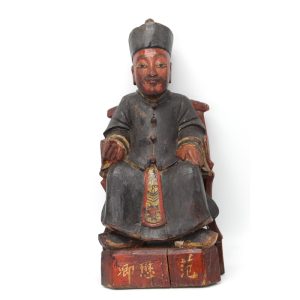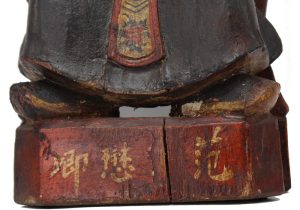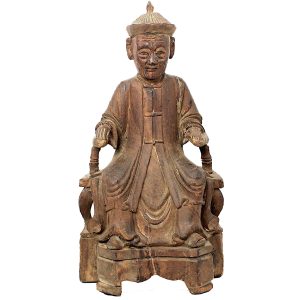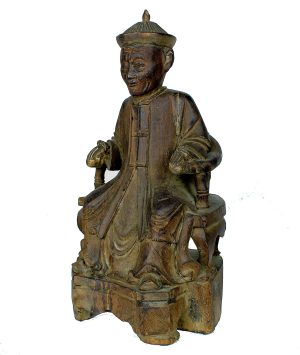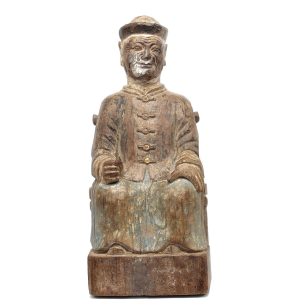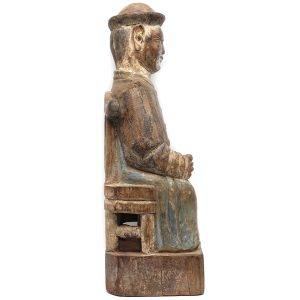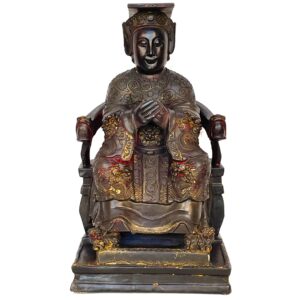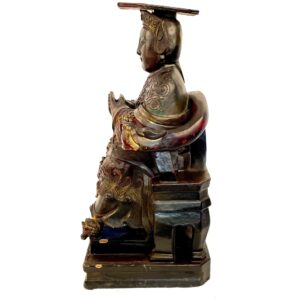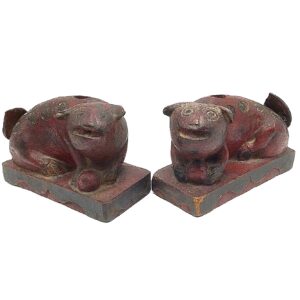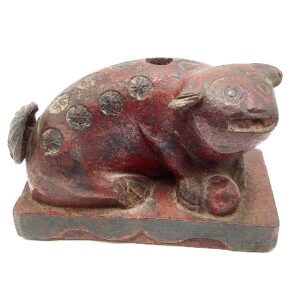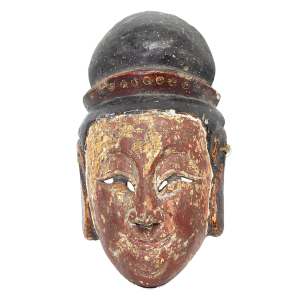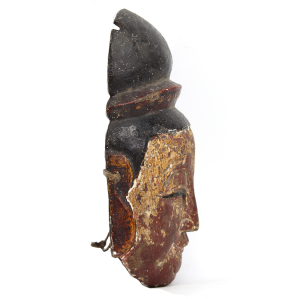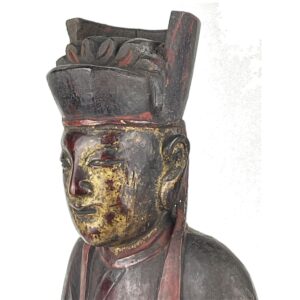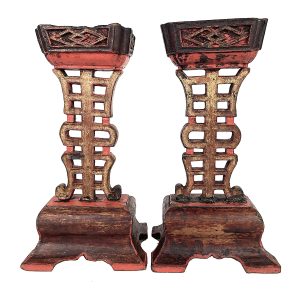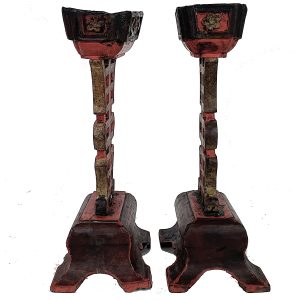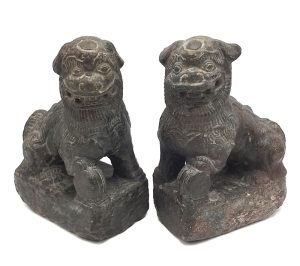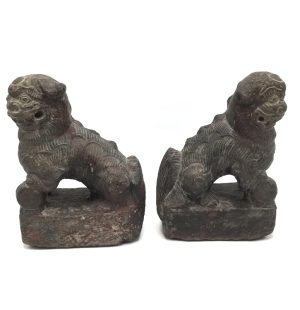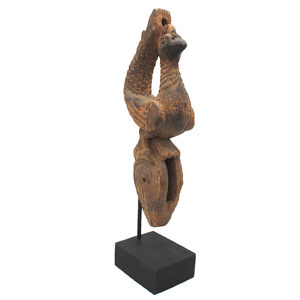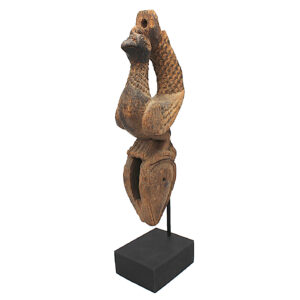Showing 37–48 of 135 results
-


$325.00
H: 14.5” W: 17.75” D: 3.375” | FREE SHIPPING WITHIN CONTINENTAL U.S.!
Finely carved figures were attached to ox cart yokes to protect farmers from malevolent spirits who inhabited all seen/unseen sectors of their world. . This beautifully carved ox cart yolk image is a chinthe, a mythical Burmese lion/dragon creature commonly decorating many everyday items. A propitious spiritual and protective guardian, the animalsymbolizes power, courage, and strength. This carving displays the common traits of a lions with a long face, large eyes, a long sharp nose, a lion-like beard, and a flame-like shape on the top of his head. Masterfully carved with careful attention to details, see the deeply incised hairs that cover his body. The 2-part piece is held together with a wooden plug. Though for daily use, Burmese craftsmen created beautiful objects and finished them with the best materials they could afford.
-


$450.00
Designation as civilian Mandarin officials was so significant that families fervently sought to perpetuate this image through generations in carved and painted ancestral renderings, especially ancestor-figures. This civilian official sits in the traditional official’s pose with arms on short armrests in an an ornately carved high back chair, curved backrest, tall legs and vertical slats…
-
Sale!


$850.00 Original price was: $850.00.$695.00Current price is: $695.00.
H: 12.75” W: 6.625” D: 5.75” | FREE SHIPPING within Continental u.s.
This masterfully carved ancestor as a mandarin official sits on horseshoe chair set on a footed high decorated plinth dressed in a well-appointed formal 3-button Mandarin long coat and pointed rattan hat. His face is uniquely and unusually individualized with heavy lidded eyes, in a benevolent expression and his advanced aged indicated by the wrinkles clearly depicting a loved individual. This exquisitely carved image in excellent condition with a fine patina was true homage to a revered family member and is one of our finest ancestor figures.
-


$595.00
During the Qing Dynasty, reverence for Mandarin officials and their associated high status with it was so significant that families sought to perpetuate this image through the generations in carved and painted renderings of their ancestors. Ancestor-figures were the highest form of filial piety, and ancestor-worship was a cornerstone of Confucianism. Stuart (p. 82) states…
-
Sale!


$1,050.00 Original price was: $1,050.00.$750.00Current price is: $750.00.
H: 15.375” W: 8.625” D: 7.5” | FOR a SHIPPING quote CONTACT US AT 213-568-3030 or email [email protected]
This Mazu, the protector of sea farers, is portrayed as the imperially sanctioned “Empress of Heaven” seated on an elaborate horseshoe shaped dragon throne, hands clasped symbolically holding a hu tablet, adorned with elegant dragon robes, an official’s girdle, a flat-topped Empress headdress and small feet resting on a pair of gilt fu lions. Meant to be seen from all sides this beautiful carving is decorated on front and back.
-


$250.00
This stylized pair of folk art tigers covered with lacquer and highlighted with black pigment was likely part of a larger item, as there are indentations on top to insert vertical extensions. The tiger is one of many ancient mythical animals, and as the mount of the Taoist god Heavenly Master Zhang Tianshi tiger images,…
-


$395.00
The origins of Nuo Opera, performed in provincial villages in Southern China since antiquity, is found in spirit and ancestor worship and Taoism. Performances use a few dozen to 200 masks having distinctive facial features, decorations, regional and ethnic individuality and aesthetic diversity. Usually carved from poplar or willow which are light and less likely…
-


$985.00
H: 15″ W: 6.5″ D: 5.5″ | EMAIL [email protected] OR CALL 213-568-3030 FOR SHIPPING COST
This excellently carved civilian official with gilt highlights was commissioned by a family to place on a home altar for veneration and to impress those who viewed it. The imposing ancestor figure grasps his belt of office to show his pride in passing examinations to become a civil official, which leads to a life of rank and prosperity for him and his family. Statues like this are an affirmation of persistence, success, status and power and they honor those who display these characteristics.
-
Sale!


$650.00 Original price was: $650.00.$450.00Current price is: $450.00.
H: 7.75” W: 3.5″ D: 3.5″ | FREE SHIPPING within continental U.S.!
This unique pair of attendants was likely placed on a home altar flanking and looking slightly inward to a Buddhist or Taoist figure or deity. Standing on circular pedestals, they smile slightly with down cast eyes presenting boxed offerings. One box has ribbons symbolizing the object’s miraculous powers and a wish for longevity. Rare to find pairs of charming figurines, they look even better on custom frosted Acrylic stands.
-
Sale!


$295.00 Original price was: $295.00.$175.00Current price is: $175.00.
H:9.25 ” W: 5.25 ” D: 3.5 ” | FREE SHIPPING WITHIN CONTINENTAL U.S.!
The pair of antique oil lamps was meant to bring good luck and happiness decorated on top with a double lozenge, a diamond shaped symbol is a lucky object that is a protective sign casting out demons and means “many treasures.” The five leaves are plum blossoms, symbols of perseverance and purity, and the Five Blessings or Happinesses – wealth, health, longevity, a peaceful death and the love of virtue As an oil lamp it was used with a wick hanging over the side.
-


$695.00
H: 8” W: 5.5” D: 3.25” | FREE SHIPPING WITHIN CONTINENTAL U.S.!
This is a really great pair of stone small fu lions with lots of character, humor, and detailed carving. Each of these very joyous creatures has open mouthed smiling faces with radiant eyebrows and tufts below their chins, scalloped manes and bushy tails. Carved from one piece of a blackish hard stone they could easily withstand additional wear of the elements in a garden. Pairs of fu lions like this belong in the home of people who appreciate spirituality and wish for happiness and fortune along with a touch of wit and whimsy.
-
Sale!


$245.00 Original price was: $245.00.$150.00Current price is: $150.00.
H: 13” W: 3.75” D: 2.625” | FREE SHIPPING WITHIN CONTINENTAL U.S.
This Burmese teak heddle pulley is topped by a graceful peacock. The peacock symbolizes wholeness, combining all colors with its spread tail and the fleeting nature of all sentient beings. Drawing on old animistic beliefs, old folk art Burmese heddles are decorated with carvings of mythical or auspicious animals providing the weaver protection and assuring good quality weaving. Mounted on wood base.
End of content
End of content

